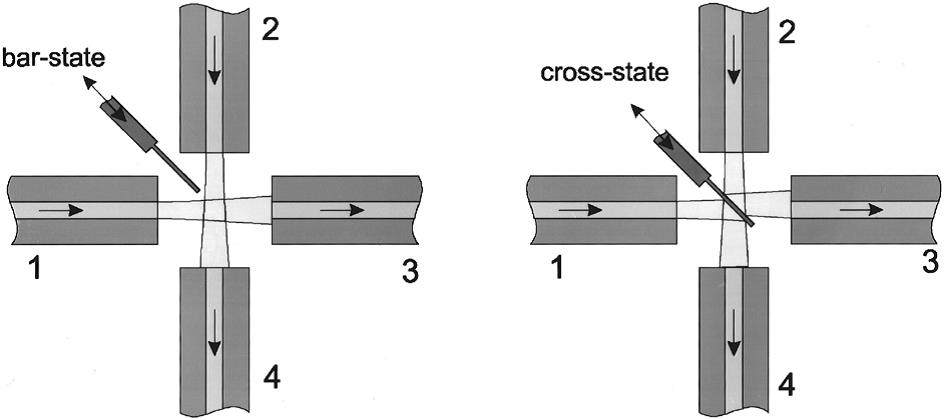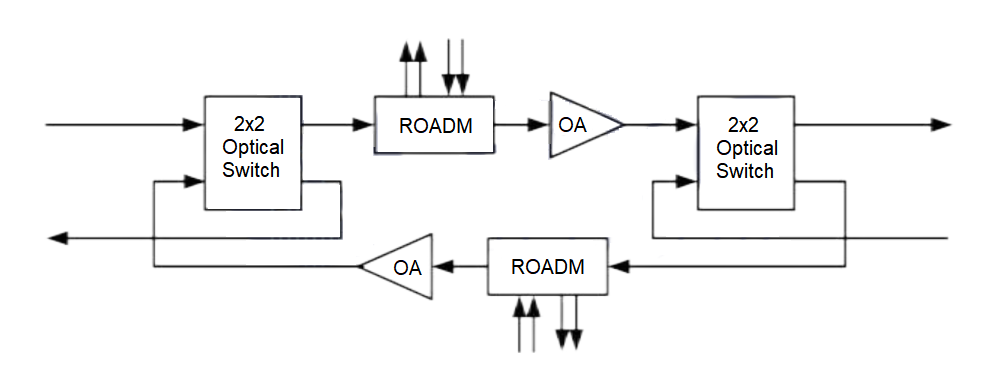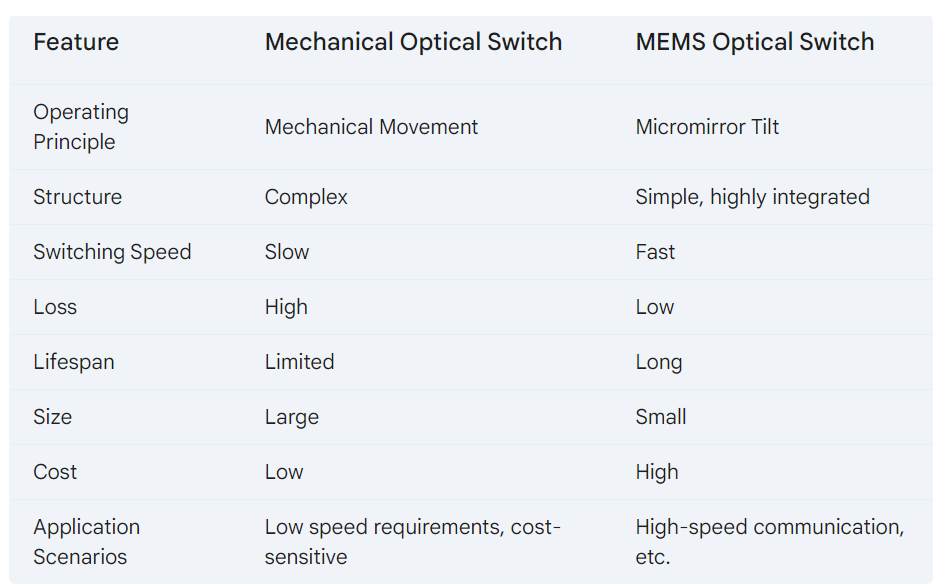Fiber Optic Tech
Optical Switches: The Backbone of Modern Optical Networks
Optical switches (OS) in optical communication systems are primarily used to physically switch optical signals or perform other logical operations in optical paths. They are frequently used as key switching devices in optical cross-connect (OXC) technology.
Optical switches have one or more selectable transmission windows and can be configured in various port configurations such as 2x2, 1xN, and MxN. Optical switches have extensive applications in optical fiber communication systems, and their implementation technologies are diverse, including: mechanical optical switches, thermo-optic switches, acousto-optic switches, electro-optic switches, magneto-optic switches, liquid crystal optical switches, and MEMS optical switches, etc. Among them, mechanical optical switches and MEMS optical switches are the two most widely used types of optical switches.
The working principle of a mechanical optical switch is to physically move the optical fiber using a mechanical device to redirect the optical signal. By moving a prism or directional coupler, the input light is directed to the desired output port. There are three main types of mechanical optical switches: one uses prism-based optical path switching technology, the second uses mirror-based switching technology, and the third switches the optical path by moving the optical fiber.
MEMS optical switches are based on micro-electro-mechanical systems (MEMS). They utilize arrays of optical mirrors or micromirrors to change the propagation direction of light beams, thereby achieving optical path switching. The principle of MEMS optical switches is quite simple. When performing optical switching, the MEMS micromirrors are moved or their angles are changed by electrostatic or electromagnetic forces, directing the input light to different output ports of the optical switch to realize optical path switching and on/off control. The schematic diagram is shown below:

As illustrated in the figure, a 2x2 MEMS-based optical switch operates on the following principle. Four optical waveguides are arranged in four directions, and a vertical MEMS micromirror is positioned at a 45-degree angle. When the micromirror is not inserted into the optical path, light beams from waveguides 1 and 2 are coupled into waveguides 3 and 4, respectively, resulting in a straight-through connection state of 1→3 and 2→4. When the micromirror is inserted into the optical path, the light beams from waveguides 1 and 2 are reflected by the micromirror and coupled into ports 4 and 3, respectively, resulting in a cross-connection state of 1→4 and 2→3.

Left: Through State; Right: Cross State.
Core Role of 2x2 MEMS Optical Switches in Optical Ring Network Protection
2x2 MEMS optical switches, characterized by their high speed and low loss, play a crucial role in optical ring network protection. Their primary function is to rapidly switch optical signals between two input and two output ports by controlling the angle of a micromirror. This enables seamless transition of traffic from a faulty link to a backup link, ensuring network continuity and reliability.
Integration of ROADM Technology with 2x2 MEMS Optical Switches
ROADM (Reconfigurable Optical Add/Drop Multiplexer) is a flexible and programmable optical network node capable of adding, dropping, multiplexing, and wavelength conversion of optical signals. Combining 2x2 MEMS optical switches with ROADM technology enables more flexible and intelligent optical network protection.
Rapid Protection Switching: ROADM nodes equipped with 2x2 MEMS optical switches can achieve millisecond-level protection switching.
Wavelength-Level Protection: ROADM can independently protect different wavelength signals, improving network utilization.
Dynamic Routing: Software-controlled 2x2 MEMS optical switches on ROADM nodes enable dynamic routing to adapt to network topology changes.
Intelligent Protection: Integration with SDN/NFV technologies enables intelligent network protection, such as self-healing and lo ad balancing.
The combination of 2x2 MEMS optical switches and ROADM technology provides a more flexible and intelligent solution for optical ring network protection. This integration enhances network reliability, reduces operational costs, and supports future network evolution.
Integration: Integrating 2x2 MEMS optical switches with other optical components for smaller packaging and higher integration.
Intelligence: Utilizing AI and machine learning for network self-adaptation and optimization.
Capacity: Increasing the capacity of 2x2 MEMS optical switches to meet future high-capacity transmission demands.

CDC ROADM (Colorless Directionless Contentionless ROADM) is a type of optical network equipment that simplifies network configuration and management by eliminating the need for specific wavelength assignments (colorless), port directionality (directionless), and contention for network resources (contentionless). This technology significantly enhances network flexibility, scalability, and efficiency.

How it Works How it Works?
CDC ROADM employs an optical switch matrix that enables flexible interconnection between different wavelength signals. The colorless, directionless, and contentionless features simplify the control logic of the switch matrix, improving configuration efficiency.
Key Features
Colorless: Wavelengths can be connected to any port without specific color assignments.
Directionless: Optical signals can be transmitted in both directions on a port.
Contentionless: Network design prevents conflicts between optical paths, improving reliability.
Advantages
Flexible Configuration: Supports any-to-any wavelength interconnection, allowing for easy network topology adjustments and optimization.
Fast Protection: Enables rapid backup and restoration of optical paths, enhancing network reliability.
Reduced Costs: Simplifies network equipment and operations, lowering network deployment and operational expenses.
Increased Capacity: Supports higher wavelength counts and faster transmission speeds to meet future network demands.
A MEMS (Microelectromechanical Systems) 1xN optical switch is an optical device that utilizes microelectromechanical technology to control the path of light signals, enabling the switching of one input to N outputs. These switches are characterized by their small size, high speed, low power consumption, and are widely used in optical communication networks.
The core component of a MEMS 1xN optical switch is a micro-mirror array. Each micro-mirror can be independently tilted or rotated to reflect the incoming light beam to different output ports. By controlling the movement of the micro-mirrors, any connection between input and output ports can be established.
Mechanical Optical Switch vs MEMS Optical Switch

With the rapid development of optical communications, optical interconnections and optical switching as key nodes in optical networks have become increasingly important, leading to a wider range of applications for optical switches. MEMS optical switches, characterized by their compact size, fast switching speed, and scalability, combine the advantages of both mechanical and waveguide switches. They offer low insertion loss, low crosstalk, low polarization sensitivity, high extinction ratio, as well as high speed, small size, and easy large-scale integration. As a result, MEMS optical switches are poised to become the mainstream direction for high-capacity optical switching networks.



















